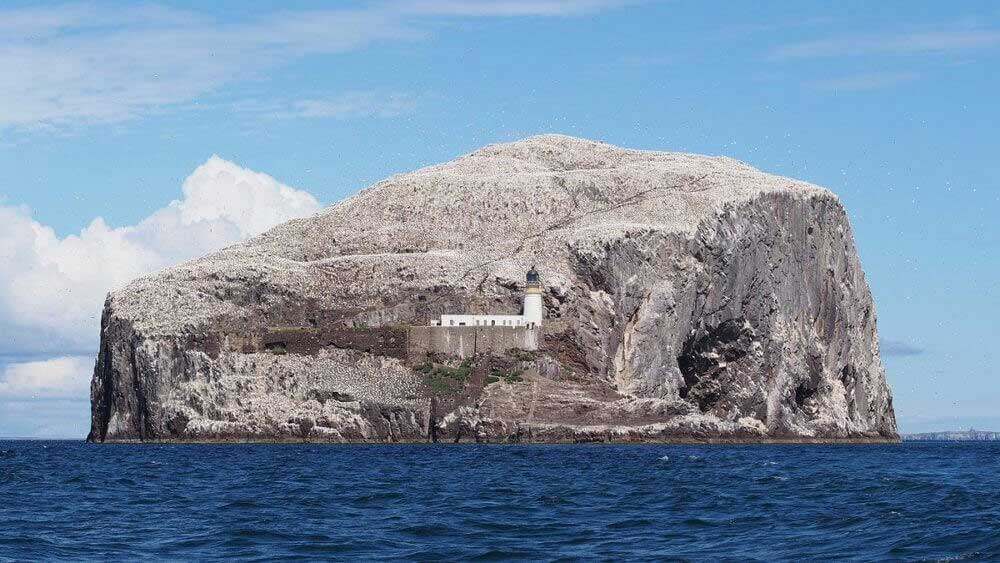
The Bass Rock, formed around 300 million years ago, is often associated with Tantallon Castle, a Historic Environment Scotland property.
Rising to around 350 feet and measuring almost a mile in circumference, the Bass Rock has a natural tunnel, only accessible at low tide, running through it.
The Bass Rock’s first resident
The Rock’s first known resident was St Baldred.
Some scholars believe he was sent to the Lothians by St Kentigern (Mungo) (518 – 613) to spread Christianity before being driven to the Bass Rock to seek safety and solitude during the wars between the Scots and the Picts.
The Venerable Bede, widely acknowledged to be one of the greatest Anglo-Saxon scholars described Baldred as Bishop of Glasgow, the successor of St Mungo.
Sadly knowledge of this reclusive monk is scant, much of it attributed to legend.
Dates of his death on the Rock vary considerably but authoritative sources cite 606 A.D.
Related Content
Today there is little to remind us of Baldred’s existence although several local geographical features bear his name and on the southern edge of the Bass Rock.
In addition, there are remains of a small undistinguished church dating from the 16th century, built in Baldred’s memory on the original site of his cell.
For Sir Walter Scott the Bass Rock was, “wild and romantic with inaccessible cliffs and home to, “the hereditary castle of the ancient family of Lauder.”
The family owned the Rock from about 1316 until it was sold to Charles II in 1671.
Death of Oliver Cromwell
Charles became king after the death of Oliver Cromwell and the collapse of the Commonwealth
He demanded the return of episcopacy and rebuilt an earlier fortress turning it into a prison to hold dissenting Presbyterian Covenanters.
For the covenanting preachers incarcerated on the Rock, their surroundings were less than romantic.
Alexander Peden, for example, one of Scotland’s best-known Covenanting ministers was confined on this bleak plug of volcanic rock as were around 40 other ministers.
In 1691 during the reign of William and Mary, a group of Jacobite prisoners escaped from their Bass Rock cells and captured the fortress when the garrison was busy unloading coal.
Remarkably the prisoners, subsequently supplied by the French, remained in control for a further three years. They were finally starved into submission but following negotiations with the Crown walked out free men.
Robert Louis Stevenson
Robert Louis Stevenson’s many observations of both the Tantallon Castle and Rock were not mere poetic licence because he knew the area well.
In the Lantern Bearers he said, “In front of all the Bass Rock, tilted seaward like a doubtful bather, the surf ringing it with white, the solan-geese hanging around its summit like a great and glittering smoke.”
This choice piece of seaboard was sacred, besides, to the wrecker; and the Bass, in the eyes of fancy still flew the colours of King James.”
The Bass Rock, its early residents, now only a distant memory, is a seasonal home to thousands of seabirds, around 150,000 gannets at peak season.
Bass Rock: Scottish Seabird Centre
Today the Scottish Seabird Centre, an independent charity, offers photographers and wildlife enthusiasts the chance to take the short boat trip to the Rock.
The boats leave for the short crossing from either Dunbar or North Berwick,
As well as the gannets you may also see, depending on the season: puffins, kittiwakes, guillemots, cormorants and other sea birds. Expert guides are part of the experience.
Scottish Seabird Centre – Visitor Information
For further information and help planning your visit to the Bass Rock, go to the Seabird Centre website.
REFERENCES & SUGGESTIONS FOR FURTHER RESEARCH AND READING
- Miller, H., 1852. Geology of the Bass Rock. R. Carter and Brothers.
- Reid, J.J., 1886, November. Early Notices of the Bass Rock and its Owners. In Proceedings of the Society of Antiquaries of Scotland (Vol. 20, pp. 54-71).
- Todman, A., 2017. A Rock with a View: Re-examining a 1680s View of the Bass Island. The New Coastal History: Cultural and Environmental Perspectives from Scotland and Beyond, pp.251-268.
- Oliver, S., 2024. A Coastal Knowledge Ecology and Aesthetics of Data: Environmental Science, JMW Turner, and the Bass Rock. Romanticism On the Net, (79).